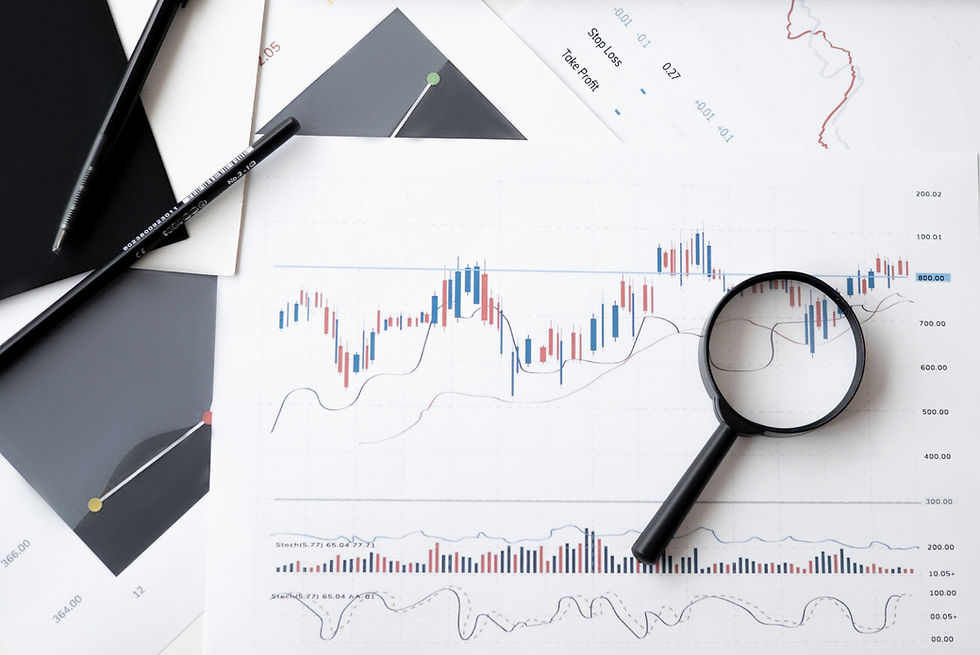Trading Against Your Benchmark: Measuring Performance
- Markets & Mayhem

- May 7, 2024
- 3 min read
It's important to track our performance, particularly against the benchmark for what we're trading. Doing so is an important exercise in assessing how well we're doing, and it's a routine we should be doing regularly -- at least once a month.
Why Benchmarks Matter
In finance, benchmarks serve as standards for evaluating performance. They provide a reference point against which traders can measure their returns, risk-adjusted or otherwise.
For example, the S&P 500 index is commonly used as a benchmark for equities trading in US markets. Similarly, futures contracts like e-mini ES (S&P 500) are often compared to this same benchmark.
We'll use the S&P 500 as an example benchmark for this article, with the assumption that ES (S&P 500 e-mini futures) are being traded against it. You may substitute your trading vehicle of choice and its respective benchmark as appropriate to help evaluate your own results.
Measuring Performance Across Multiple Timeframes
To get an accurate picture of your performance relative to the market, it's essential to evaluate returns across multiple time frames:
Daily: How do you perform on a daily basis? Are you consistently beating or lagging behind the S&P 500?
Weekly: Do your weekly results align with those from shorter-term analysis (daily)?
Monthly, Quarterly, and Yearly: Assess performance over these longer time frames to identify any seasonal patterns, trends, or anomalies.
Factoring in Dividends
When evaluating the S&P 500 as a benchmark for e-mini ES trading, it's crucial not only to consider price movements but also dividend payments.
These dividends can significantly impact total returns and must be accounted for when comparing your performance with that of the market index (S&P 500).
Including Your Own Costs in Performance Calculations
To ensure an accurate assessment of your overall profitability, factor in all costs associated with trading:
Slippage: The difference between expected entry/exit prices and actual execution prices.
Commissions: Fees charged by brokers for executing trades.
Margin fees: Interest rates or other charges imposed on margin accounts.
Data fees: Any fees for your S&P 500 futures trading and other related data you may use
Software fees: Trading software licensing costs
Tax treatment: While 60/40 tax treatment is preferable on futures vs trading stocks or ETFs, it is still not as cost effective as long-term capital gains on a passive investment in something like SPY. Be sure you compare apples to apples on your profits and how they are taxed.
Other fees: Tax preparation, broker fees, LLC costs (if you maintain one for trading) and any other additional costs you incur to trade and manage your trading
Add everything together and determine what your all-in costs are for trading so you can net them out of your profits to have a fair comparison against your benchmark's performance.
Interpreting Your Results
After collecting data across multiple time frames, including dividends and costs:
If you're consistently outperforming the S&P 500 in pure performance terms (price movements), that's a strong indication of success.
However, if your returns are not beating those of the benchmark after accounting for dividend payments and your own costs, it is then a good time to reassess your strategy and determine where you are underperforming and why. A trading journal can help quite a lot with that assessment process and is something I recommend all traders maintain regardless of experience or skill levels.
Improving Your System
If you've identified strengths and weaknesses:
Focus on refining or adjusting strategies to address performance gaps (e.g., improving risk management techniques).
Continue monitoring progress across multiple timeframes.
Adapt your approach as necessary based on new insights gained from analysis.
Reevaluating Strategies When Necessary
Unfortunately, even with diligent effort, some traders may not be able to consistently beat their benchmark. In such cases:
Consider alternative trading environments: Explore other markets or asset classes where you might find opportunities.
Adjust your time frame focus: If struggling in a specific market (e.g., daily), try shifting attention to longer-term trades.
In closing, measuring performance against the S&P 500 benchmark for e-mini ES futures contracts requires careful consideration of multiple factors: price movements, dividend payments, and trading costs.
By regularly evaluating progress across various time frames and refining your approach as needed, you can optimize returns and achieve consistent success in today's dynamic markets.

.png)



コメント